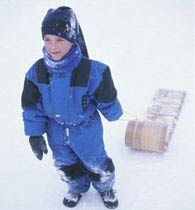This is the VOA Special English Health Report.
Freezing weather can mean frostbite and hypothermia unless a person is prepared. Today we talk about how to stay warm, dry and safe.

Frostbite is damage that happens when skin is exposed to extreme cold for too long. It mainly happens on the hands, feet, nose and ears.
People with minor cases of frostbite that affect only the skin may not suffer any permanent damage. But if deeper tissue is affected, a person is likely to feel pain every time the area gets cold.
If blood vessels are damaged, people can suffer an infection of gangrene. Sometimes, doctors have to remove frostbitten areas like fingers and toes.
Hypothermia happens when the body cannot produce as much heat as it releases. The condition comes on slowly. Signs of hypothermia include uncontrollable shaking, very slow breathing and difficulty thinking clearly. If not treated, hypothermia can be deadly.
To avoid cold-related injuries, here is a simple way to remember four basic steps to staying warm. Think of COLD -- C.O.L.D.
The C stands for cover. Wear a hat and scarf to keep heat from escaping through the head, neck and ears. And wear mittens instead of gloves. In gloves, the fingers are separated, so the hands may not stay as warm.
The O stands for overexertion. Avoid activities that will make you sweaty. Wet clothes and cold weather are a bad mix.
L is for layers. Wearing loose, lightweight clothes, one layer on top of another, is better than wearing a single heavy layer of clothing. Also, make sure outerwear is made of material that is water resistant and tightly knit.
Can you guess what the D in COLD stands for? D is for dry. In other words, stay as dry as possible. Pay attention to the places where snow can enter, like the tops of boots, the necks of coats and the wrist areas of mittens.
And here are two other things to keep in mind, one for children and the other for adults. Eating snow might be fun but it lowers the body's temperature. And drinking alcohol might make a person feel warm. But what it really does is weaken the body's ability to hold heat.
Next week: advice from experts about what to do, and not to do, to help someone injured by extreme cold.
And that's the VOA Special English Report, written by Caty Weaver. For more health news, along with transcripts and MP3s of our reports, go to voaspecialenglish.com. I'm Steve Ember.
frostbite: injury or destruction of skin and underlying tissue, most often that of the nose, ears, fingers, or toes, resulting from prolonged exposure to freezing or subfreezing temperatures 凍瘡
hypothermia: abnormally low body temperature 低體溫癥
gangrene: death and decay of body tissue, often occurring in a limb, caused by insufficient blood supply and usually following injury or disease 壞疽
mitten: a covering for the hand that encases the thumb separately and the four fingers together 連指手套
Related stories:
Cold snap to blanket Beijing in more snow
寒潮 cold snap
Cold snap brings snow
寒流襲來 暖處過節成新寵
冬季如何遠離感冒?
(來源:VOA 編輯:陳丹妮)